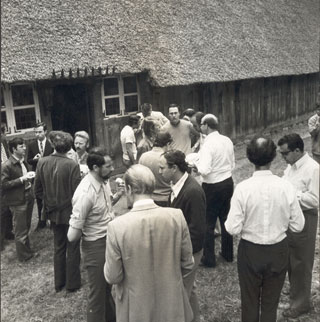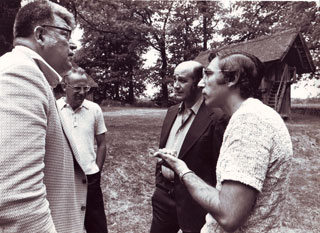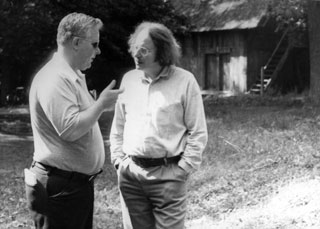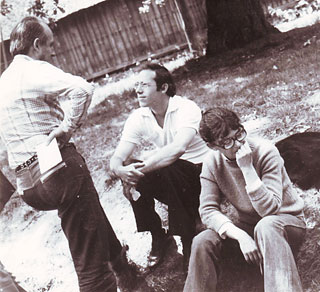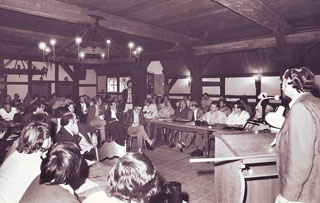Discussion following Dr. Stohlman's Talk
Edited by Tim Hunt and Rüdiger Hehlmann
Dr. Ostertag: Dr. Stohlman, you are talking about three compartments of the hemopoietic system: the compartment of the pluripotent stem cell, the compartment of committed stem cells and the differentiated compartment of megakaryocytes of myeloid and erythroid elements. You further say that in your view leukemia originates back in the pluripotent stem cell compartment. As supportive evidence you cite the chromosomal change as observed in CML as Philadelphia chromosome, which can be found in cells of all three compartments. Now you do get a specific chromosomalchange in many patients all suffering from chronic myelocytic leukemia; why can't you get the Same kind of chromosomal translocation at the Same time in different compartments of the hemopoietic system of the Same patient. A viral etiology could easily account for that.
Dr. Stohlman: If we assume for the moment a viral etiology, and I would suggest weare really talking about a virus, then this virus theoretically might affect DNA in a number of ways. The numbers of different types of leukemia are quite restricted, which leads me to think that most effects of viruses are lethal. Whether the immunologic surveillance system identifies and destroys those transformed cells which are recognized as abnormal, perhaps due to membrane changes, or the transformation results in an intrinsically abnormal cell which dies, perhaps after a few divisions, I don't know. The reason a Person gets chronic myeloic leukemia, acute myelocytic leukemia or acute lymphocytic leukemia may be either due to the species of virus that transforms the molecule or the Same species may hit DNA at random, most of the lesions being lethal, only a few of them being compatible with proliferation; the Philadelphia chromosome is one manifestation and is associated with CML. It would be most improbable for all patients to have three different cell types affected simultaneously.
Dr. Ostertag: I would like to disagree. Let's say a virus is going into the cells affecting the Same place in the DNA and breaking the Same chromosome in all cells. You would get the Same change in all different compartments of the hemopoietic tissue.
Dr. Gallo: That is a perfectly acceptable alternative possibility, and most particularly since a common chromosomal alteration appears limited to CML.
Dr. Stohlman: You also have CML without the Philadelphia chromosome.
Dr. Gallo: Where there are marker chromosomes in AML or ALL you usually do not See them in all three cell lines.
Dr. Stohlman: But you do See the Same abnormalities in all three cell lines.
Dr. Hardesty: If leukemia is a stem cell disease, what do you think is the cytological basis of the disease: do the stem cells replicate too rapidly or do their daughters stick around too long? You further mentioned a colony stimulating factor that is involved in the regulation of myelopoiesis. If one assumes that the normal myeloblast and the leukemic one has a factor, the normal cells should be dominant over the diseased cells. Has somebody tried to make a fusion between leukemic and normal myeloblasts? If the hypothesis is true the normal cells should be able to cure a cancer cell.
Dr. Gallo: To answer your second question first: I don't know if it has been tried yet in vitro. However, many people with abnormal bone marrows were transfused with normal cells. In a few instances apparent transformation of the donor normal cells in the recipient leukemia patient developed. Whether this was due to cell fusion remains doubtful but this would be an argument against your hypothesis (i. e. dominance by a normal cell). To your first question I would say, I am not convinced that leukemias are "stem cell" diseases. If the origin (first cell affected) is always, indeed, the stem cell, then I would say, proliferating stem cells give rise to too many myeloblasts in places they normally should not be. Normal granulocytes go all over the body, they often for instance localiie in areas of infection. In short, it might be said that they "metastasize" just like cancer cells, but they know how to terminate, to die. They do not have the potential for continued replication.
Dr. Stohlman: Normal myeloblasts, progranulocytes and myelocytes stay where they are supposed to, namely the bone marrow but abnormal leukemic myeloblasts are Seen elsewhere. The abnormal myeloblast grows in extramedullary sites, divides and replicates itself, or in my view it is more likely that the leukemic stem cell is responsible and it and its progeny (the myeloblast etc.) grow in extramedullary sites. The normal fate of a granulocyte is to be released from the bone marrow and to go into the peripheral blood, to go from the peripheral blood to skes of infection. This cell does not have the capacity to divide. The polymorphonuclear granulocyte is an end stage cell just as the red cell, the normal fate of which, after extruding its nucleus, is to enter the peripherial blood, circulate, provide oxygen, and then die in anywhere from 3Odays to 10 months depending upon the species. But the myeloblasts and myelocytes do not normally enter the peripheral blood. There is the reason to suggest that this is due to membrane characteristics, namely stickiness and a lack of deformability which prevent early myeloid elements from entering the peripheral blood. Part of maturation is to develop deformability, and lose the "stickiness". In order to release myeloblasts into the peripheral blood there must be an abnormal bone marrow architecture or an abnormal membrane either of which would alter the interaction of the cells with the environment. When you inject myeloblasts into the peripheral blood or stem cells into the peripheral blood, they hone and grow only in the bone marrow or in the spleen.
Dr. Gallo: Let's discuss tuberculosis or other like diseases where immature normal cells including myeloblasts are released into peripheral blood.
Dr. Stohlman: What Dr. Gallo is referring to, is a leukomoid reaction which one occasionally Sees in tuberculosis and usually what this means is that immature cells are circulating into the peripheral blood. Myeloblasts are not Seen in these situations and moreover the cells in leukomoid reaction don't proliferate.
Dr. Hardesty: What happens when a patient goes into remission? It seems that this is apertinent question with respect to whether it is a specific block or whether it is some thing way back.
Dr. Stohlman: 1'11 give you my thought on that. Normally, you have, what I've been referring to as a pluripotent stem cell and for purposes of conversation it's very easy to consider this a homogenous or uniform compartment. However, it probably is not, one might suggest that a given pluripotent stem cell has a finite limit to the extent of this replication and once exhausted another more immature stem cell is triggered to begin differentiation and you have what is called "clonal" succession. Now, if you treat a leukemic patient with chemotherapeutic agents and induce a remission what may be happening is that a normal stem cell line has differentiated out, remission will last as long as one continues to have normal stem cells differentiate. Relapse Comes when either the succeeding stem cell is leukemic or perhaps virus has transformed another normal cell, the presumption being that if you have the capacity for remission then you have normal stem cells present along with leukemic cells.
Dr. Hardesty: You haven't answered the question really. What happens in this respect with Friend virus induced mouse leukemia? In my experience, the spleens are just literally enlarged. The animal is ovenvhelmed with cells. If there is a remission in this kind of situation do these cells go on and differentiate or do they die?
Dr. Stohlman: In human acute myelocytic leukemia you kill the cells. If you give a patient with acute myelocytic leukemia Daunomycin it wipes out almost all of his cells. You then go through an aplastic phase and then if there is regeneration from a normal pluripotent stem cell, recovery is seen. The Friend virus which produces an erythroleukemia in mice does not have a Counterpart in human tissue and hence I am not certain that discussion of this is germane to the present problem.
Dr. Hofschneider: I would like to know the difference between a chronic and an acute leukemia in cellular terms or whatever terms you like. Do you have cells in chronic leukemia that do not grow as fast as in the acute form?
Dr. Stohlman: Chronic myelocytic leukemia is a disease of myeloid cells in the peripheral blood and bone marrow. Immature cells (myelocytes, progranulocytes and myeloblasts) which normally are not present in the peripheral blood are present. It may be associated with anemia, polycythemia, thrombocytosis or thrombocytopenia. Classically there is a decrease in leukocyte alkaline phosphatases. Acute myelocytic leukemia, of the classical variety in young people, is associated with a large increase in the number of myeloblasts in the bone marrow and myeloblasts are present in the peripheral blood without evidence of differentiation such as is Seen in the chronic myelocytic leukemia (i. e. in chronic leukemia differentiation is seen). In AML there may be growth of the leukemic cells outside the bone marrow. It could be the lungs, the heart, the brain, the skin and so On. Patients with chronic myelocytic leukemia, at some point develop a blast cell crisis which mimics acute myeloblastic leukemia.
Dr. Hunt: If human leukemias are caused by viruses, do you say the virus infects and is present in the genome of the pluripotent stem cells, and again if that is true, why does it only affect one cell line? What is your explanation for that? Have you ever tried looking in these leukemic patients in any other cell types for the presence of virus particles or viral genomes in the DNA? And what is the answer?
Dr. Gallo: The answer is no, we have not looked at other cell types or tissues, only the affected cells, but it is a very good point. Perhaps I can speculate. I think it's possible that some people are infected with a leukemia virus from without which carries information essential to the induction. This has not been ruled out. However, I don't think infectivity from without is going to be the common mechanism for cancer causation in man. There may be people who disagree with that. By "infectivity from without" I mean active viral infection within in a relatively short period of time relative to the onset of the disease.
Dr. Stohlman: If I may comment on this point. The myeloblast of course predominates in this disease and one can obtain enough cells to examine. But to determine whether there is virus or transcriptase in other cells, erythroid, megakaryocytes etc. will require more refined techniques as there are not enough cells to permit study with current methods.
Dr. Gallo: You're right. We need a better microtechnique. The antibody idea I think is now very feasible. We have available antibodies to primate Type Cvirus reverse transcriptase. They Cross with the human enzyme, at least some that we've recently isolated. Therefore, we can develop, hopefully a possibility of looking at small quantities of cells by immunochemical methods. This will be a major thrust of our future work in this area.

